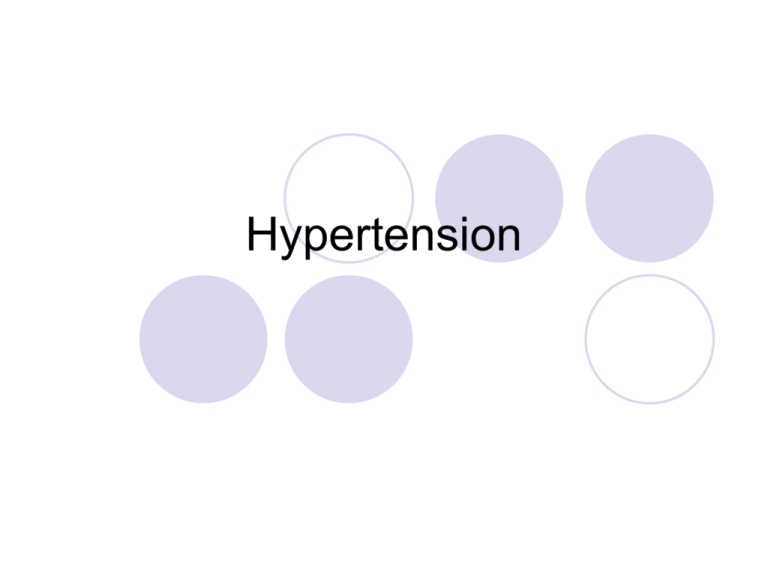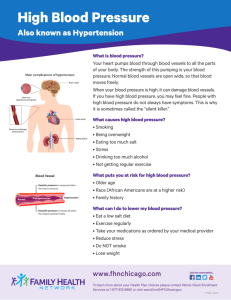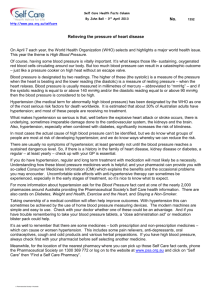
Hypertension
Introduction
Hypertension is defined as a consistent elevation of arterial
pressure above the normal range expected for a particular
age group.
it is now identified as one of the most significant risk
factors for cardiovascular (CV) disease in the United
States.
Increasing awareness and diagnosis of hypertension, and
improving control of BP with appropriate treatment, are
considered critical public health initiatives to reduce CV
morbidity and mortality.
Data from 2003 to 2006 indicate that of
the population of Americans with
hypertension
77.6% are aware that they have hypertension,
only 67.9% are on some form on
antihypertensive treatment,
and only 44.1% of all patients have controlled
BP.
EPIDEMIOLOGY
Approximately 31% of Americans (74.5
million people) have elevated BP, defined
as greater than or equal to 140/90 mm Hg.
BP values increase with age,
and hypertension (persistently elevated
BP values) is very common in the elderly.
during a 5-year period between 1995 and
2000 in Saudi Arabia
The prevalence of hypertension was 26.1% in
crude terms. For males, the prevalence of
hypertension was 28.6%, while for females; the
prevalence was significantly lower at 23.9%
(p<0.001).
ETIOLOGY
In most patients, hypertension results from
unknown pathophysiological etiology
(essential or primary hypertension ).
This form of hypertension cannot be
cured, but it can be controlled.
A small percentage of patients have a
specific cause of their hypertension
( secondary hypertension ).
There are many potential secondary
causes that either are concurrent medical
conditions or are endogenously induced. If
the cause can be identified, hypertension
in these patients can be mitigated or
potentially be cured.
Hypertension
Arterial BP is hemodynamically generated
by the interplay between blood flow and
the resistance to blood flow. It is
mathematically defined as the product
of cardiac output (CO) and total peripheral
resistance (TPR) according to the
following equation:
BP = CO TPR
x
Arterial BP = Cardiac Output (CO) x Systemic
vascular resistance (SVR)
Cardiac Output = stroke volume x beats per min
Systemic vascular resistance = force opposing
the movement of blood within the blood vessels
stroke volume = The volume of blood pumped
by one ventricle during one contraction.
Primary or essential hypertension
Over 90% of individuals with high BP have essential
hypertension
Genetic factors may play an important role in the
development of essential hypertension
several theories have been proposed to explain the
mechanism of its occurrence. Involving:
chronic increases in fluid volume,
enhanced sympathetic activity or
abnormal salt and water excretion by the kidneys
A number of key physiologic changes have also been
observed in the kidneys of patients with essential
hypertension that may contribute to the development of
the disorder.
These renal changes include
increased resistance to renal blood flow,
decreased renal blood flow with disease progression and
inadequate excretion of fluid and electrolytes at normal blood
pressures.
Diagnosis and classification
Hypertension is termed the silent killer because most
patients do not have symptoms.
The primary physical finding is elevated BP.
The diagnosis of hypertension cannot be made based on
one elevated BP measurement
The average of two or more
measurements taken during two or more
clinical encounters should be used to
diagnose hypertension.
This BP average should be used to
establish a diagnosis, and then classify the
stage of hypertension using
TABLE 19-3. Classification of Blood Pressure in Adults
(Age ≥18 Years)
© The McGraw-Hill Companies.
All Rights Reserved.
Risk Factors for the Development of Essential
Hypertension
A number of genetic, environmental and dietary factors are
associated with an increased risk for the development of
essential hypertension:
Familial history of hypertension
Increasing age
Race and gender: incidence of hypertension is
significantly higher in black men
High dietary salt intake
Hyperinsulinemia
Heavy alcohol consumption
Obesity
Cigarette smoking
Low dietary intake of potassium, calcium and
magnesium
Blood Pressure Measures
Systolic blood pressure = the pressure in the arteries
when the ventricles are contracting
Diastolic blood pressure = the pressure in the arteries
when the ventricles are relaxed
Mean arterial pressure = average blood pressure in the
arteries, estimated as diastolic blood pressure + one
third of the pulse pressure
Pulse pressure = systolic blood pressure – diastolic
blood pressure
Methods for Measuring Blood Pressure
Sphygmomanometer (blood pressure cuff) — indirect
measure
Intra-arterial catheter — direct measure
Manifestations of essential hypertension
Although a small percentage of patients with
essential hypertension may present with
frequent headaches, most are asymptomatic.
As a result, essential hypertension may go
undetected and untreated for a number of years.
Unless diagnosed early by blood pressure
screening and treated appropriately, chronic
essential hypertension can progressively
damage tissue and organs.
Hypertension-Associated Target-Organ Damage
chronic essential hypertension can progressively damage tissue and
organs, including:
1- Blood vessels — Prolonged high blood pressure in the arteries and
arterioles will cause the walls of the blood vessels to thicken to
compensate for the excess stress.
The chronic increased forces that the blood vessel walls are
exposed to also predispose them to atherosclerosis and aneurysm.
As a result, untreated essential hypertension puts patients at a
greater risk of coronary artery disease, cerebrovascular disease and
renal vascular disease.
The risk for atherosclerosis is exacerbated in hypertensive patients
who have high serum cholesterol, are obese, have diabetes or who
smoke.
2- Heart — Chronic elevation of arterial pressure means
the heart must now pump blood out against a continually
elevated afterload. As compensation for this increased
afterload, left ventricular hypertrophy occurs.
The hypertrophied ventricle will require increased blood,
oxygen and nutrient supplies and will be at greater risk
for arrhythmia.
When the ventricular enlargement reaches a certain
point, contractile function will no longer be supported and
pump failure (congestive heart failure, CHF) will ensue.
3- Kidneys — Chronically elevated pressure can damage
the renal vasculature and compromise renal blood flow,
oxygen delivery and filtration. As a result, renal
insufficiency can occur that may eventually progress to
renal failure
Decreased renal blood flow can lead to activation of the
renin–angiotensin system and contribute to a cycle of
increasing blood pressure and decreasing renal function.
Hypertension-induced renal injury is exacerbated in
patients with diabetes.
4- Eyes — Vision can suffer in a patient with chronic
hypertension as a result of increased arteriolar pressure
in the eyeball or from vascular sclerosis, both of which
can damage the retina and eye as a whole.
Secondary hypertension
Fewer than 10% of patients have secondary hypertension where
either a comorbid disease or drug (or other product) is responsible
for elevating BP
One of the most common causes of secondary hypertension is renal
artery stenosis, which is a narrowing of the renal arteries due to
atherosclerosis.
As a result of the reduced renal blood flow that accompanies the
narrowed blood vessels, the kidney responds by activating the
renin–angiotensin system that in turn leads to vasoconstriction and
salt and water retention.
Causes of secondary hypertension can include:
- renal artery stenosis
- Hyperaldosteronism (excess aldosterone production)
- Pheochromocytoma (tumor of the adrenal medulla).
Secondary hypertension caused by renal artery stenosis
may be effectively treated by ACE inhibitors or may be
resolved with angioplasty or surgical intervention to
reopen the occluded renal blood vessels
Malignant hypertension
In a small percentage of patients with chronic essential
hypertension, dramatic increases in blood pressure
(greater than 120 to 130 mmHg diastolic pressure) may
occur suddenly.
These sudden increases in blood pressure are termed
malignant hypertension and are especially dangerous
because dramatic increases in pressure may damage
the retina or kidneys and lead to cerebral edema and
stroke.
Malignant hypertension requires immediate medical
treatment with powerful intravenous vasodilators such as
diazoxide or sodium nitroprusside.
Hypertensive Emergency : Elevated BP , there is
evidence of end-organ damage
Hypertensive Urgency : elevated BP but without
evidence of end-organ damage
Hypotension
Hypotension is an abnormally low blood pressure. One
common form of hypotension is orthostatic hypotension
(also called postural hypotension ) that occurs upon
standing.
The act of standing initiates a series of reflex responses
in the body that are designed to prevent pooling of blood
in the lower extremities and a decrease in blood
pressure. These reflexes include vasoconstriction in the
lower limbs and a reflex increase in heart rate.
Causes of Orthostatic Hypotension
Aging — Associated with reduced baroreceptor
responses, decreased cardiac output and reduced
vascular responsiveness
Decreased blood or fluid volume — Caused by
dehydration, diarrhea, diuretic use
Autonomic nervous defects — An inability to initiate
vasoconstriction and increased heart rate reflexes
Prolonged bed rest
Drug-induced — Examples: antihypertensive drugs,
calcium channel blockers, vasodilators
Idiopathic — Cause is not known
Manifestations
Dizziness (syncope)
Decreased cardiac output
Reduced brain blood flow
Pooling of blood in the extremities
Falls and injuries, particularly in elderly individuals
Thank You







